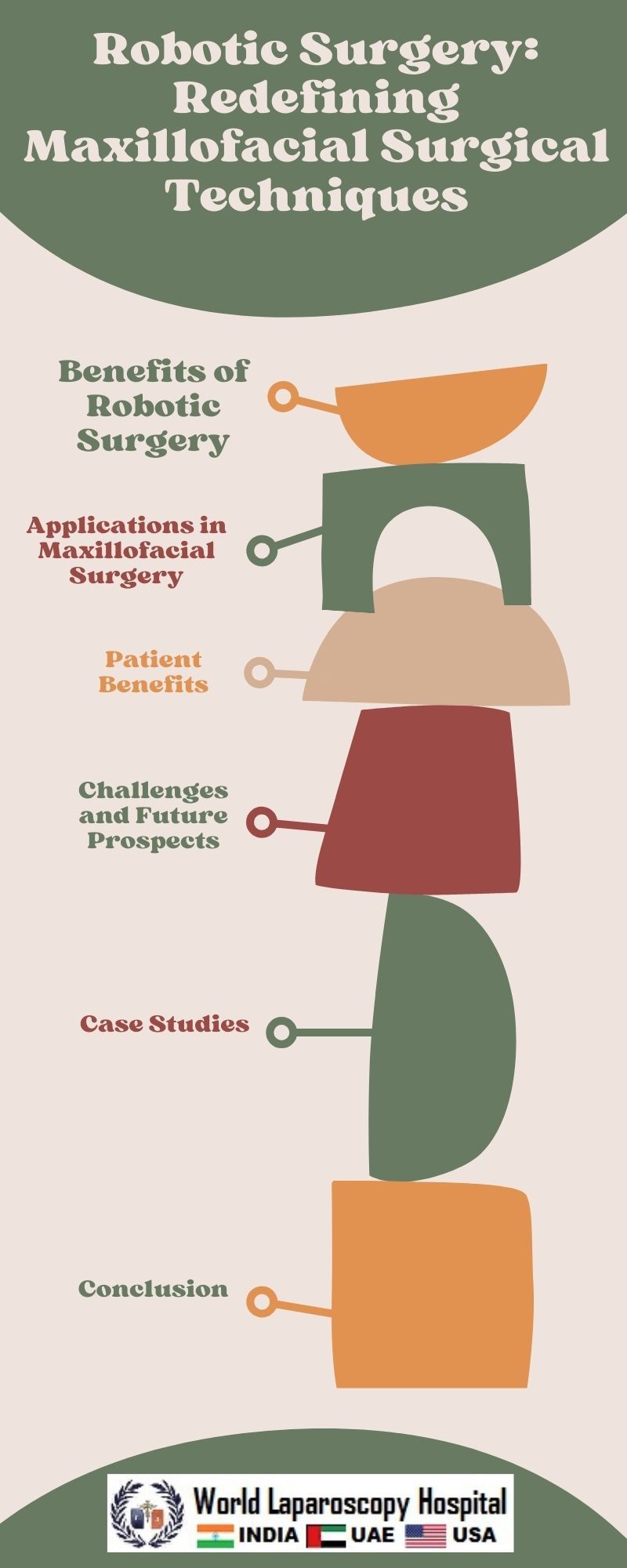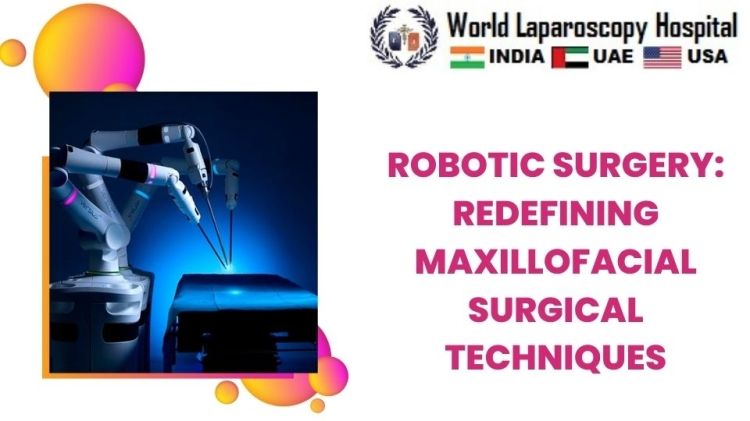Robotic Surgery: Redefining Maxillofacial Surgical Techniques
Introduction:
The field of maxillofacial surgery has witnessed a paradigm shift in recent years with the advent of robotic surgery. This cutting-edge technology is redefining the way surgeons approach complex procedures, offering unprecedented precision, improved outcomes, and reduced recovery times. As we delve into the world of robotic surgery in maxillofacial procedures, this article explores the evolution of this technology, its applications, benefits, challenges, and the potential it holds for the future of surgical interventions.

The Evolution of Robotic Surgery:
Historical Perspective:
The concept of robotic surgery traces its roots back to the mid-20th century, with the development of early telemanipulators. However, it wasn't until the 1980s that the first robot-assisted surgery took place, marking the beginning of a transformative journey in the field of medicine. Over the years, advancements in robotics, computer technology, and artificial intelligence have propelled the evolution of robotic surgery.
Robotic Systems in Maxillofacial Surgery:
The integration of robotics into maxillofacial surgery has been a gradual process. Robotic systems like the da Vinci Surgical System have gained popularity for their versatility and precision in various surgical disciplines. In maxillofacial surgery, the use of robotic platforms allows for intricate procedures involving the jaw, face, and skull with unparalleled accuracy.
Applications of Robotic Surgery in Maxillofacial Procedures:
Orthognathic Surgery:
Robotic surgery has revolutionized orthognathic procedures, which involve correcting the alignment of the jaw. With robotic assistance, surgeons can precisely plan and execute complex osteotomies, resulting in improved facial aesthetics and functional outcomes. The three-dimensional visualization provided by robotic systems enhances the accuracy of bone repositioning.
Tumor Resection:
Maxillofacial tumors present unique challenges due to their proximity to critical structures. Robotic surgery enables surgeons to navigate and remove tumors with precision, minimizing damage to surrounding tissues. This is particularly crucial in preserving facial aesthetics and maintaining optimal function after tumor resection.
Temporomandibular Joint (TMJ) Surgery:
The temporomandibular joint is a complex structure, and its disorders can significantly impact a patient's quality of life. Robotic surgery aids in performing intricate TMJ surgeries, allowing for precise manipulation and reconstruction. This results in better postoperative outcomes, reduced pain, and improved joint function.
Benefits of Robotic Surgery in Maxillofacial Procedures:
Precision and Accuracy:
One of the primary advantages of robotic surgery is its unparalleled precision. Robotic systems offer a level of accuracy that surpasses traditional surgical techniques, particularly in delicate maxillofacial procedures. This precision translates into improved surgical outcomes, reduced complications, and enhanced patient satisfaction.
Enhanced Visualization:
Robotic platforms provide surgeons with three-dimensional, high-definition visualization of the operative field. This enhanced visual feedback facilitates meticulous planning and execution of surgical maneuvers. Surgeons can navigate through complex anatomical structures with greater confidence, leading to improved decision-making during surgery.
Minimally Invasive Approach:
Many robotic procedures in maxillofacial surgery are minimally invasive, involving smaller incisions compared to traditional open surgeries. This results in reduced trauma to surrounding tissues, less postoperative pain, and faster recovery times for patients.
Improved Ergonomics for Surgeons:
Robotic systems are designed to enhance the ergonomics of the surgical environment. Surgeons operate the robotic console in a comfortable seated position, with hand and foot controls translating their movements to the robotic arms. This minimizes the physical strain on surgeons during lengthy procedures, potentially reducing fatigue and enhancing overall performance.
Challenges and Considerations:
Cost and Accessibility:
Despite the undeniable benefits, the initial cost of acquiring and implementing robotic systems in maxillofacial surgery can be substantial. This raises concerns about accessibility, as not all medical institutions may have the financial resources to invest in this technology. Striking a balance between cost-effectiveness and the potential advantages of robotic surgery remains a challenge.
Training and Learning Curve:
Proficiency in robotic surgery requires specialized training for surgeons and the surgical team. The learning curve associated with mastering robotic systems is a consideration, and institutions must invest in comprehensive training programs to ensure safe and effective use of the technology. Additionally, ongoing education is crucial to keep surgical teams updated on the latest advancements.
Ethical and Legal Implications:
The integration of robotics in maxillofacial surgery raises ethical questions, particularly regarding the potential overreliance on technology. Issues related to patient consent, disclosure of risks and benefits, and the ethical implications of autonomous robotic procedures require careful consideration. The legal framework surrounding robotic surgery is also evolving, and establishing guidelines for responsible use is essential.
Future Perspectives and Innovations:
Artificial Intelligence Integration:
The future of robotic surgery in maxillofacial procedures is closely linked to the integration of artificial intelligence (AI). AI algorithms can enhance surgical planning, optimize robotic movements, and even contribute to real-time decision-making during surgery. This synergy between robotics and AI holds tremendous potential for further refining surgical outcomes.
Customization and Personalization:
Advancements in 3D printing and personalized medicine are paving the way for customized implants and prosthetics in maxillofacial surgery. Robotic systems can be seamlessly integrated with these technologies, allowing for personalized treatment plans tailored to each patient's unique anatomy. This approach promises to enhance the precision and effectiveness of surgical interventions.
Global Collaboration and Knowledge Sharing:
As robotic surgery continues to evolve, global collaboration and knowledge sharing among medical professionals become imperative. Establishing platforms for sharing best practices, research findings, and experiences with robotic maxillofacial surgery can accelerate the adoption of this technology worldwide. This collaborative approach can also contribute to addressing challenges and refining techniques.
Conclusion:
Robotic surgery has undeniably redefined maxillofacial surgical techniques, offering unprecedented precision and opening new frontiers in patient care. While challenges such as cost, training, and ethical considerations persist, the ongoing evolution of robotic systems, coupled with advancements in artificial intelligence, promises a future where the benefits of this technology become even more accessible and transformative. As we stand at the intersection of technology and healthcare, the journey of robotic surgery in maxillofacial procedures is a testament to human innovation and the relentless pursuit of improving the quality of surgical interventions for the benefit of patients worldwide.
